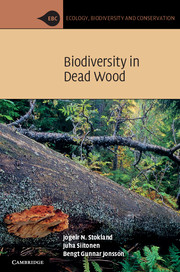Book contents
- Frontmatter
- Contents
- Preface
- 1 Introduction
- 2 Wood decomposition
- 3 The saproxylic food web
- 4 Other associations with dead woody material
- 5 Host-tree associations
- 6 Mortality factors and decay succession
- 7 Microhabitats
- 8 Tree size
- 9 The surrounding environment
- 10 Evolution of saproxylic organisms
- 11 Species diversity of saproxylic organisms
- 12 Natural forest dynamics
- 13 Dead wood and sustainable forest management
- 14 Population dynamics and evolutionary strategies
- 15 Threatened saproxylic species
- 16 Dead wood in agricultural and urban habitats
- 17 The value and future of saproxylic diversity
- References
- Index
12 - Natural forest dynamics
Published online by Cambridge University Press: 05 June 2012
- Frontmatter
- Contents
- Preface
- 1 Introduction
- 2 Wood decomposition
- 3 The saproxylic food web
- 4 Other associations with dead woody material
- 5 Host-tree associations
- 6 Mortality factors and decay succession
- 7 Microhabitats
- 8 Tree size
- 9 The surrounding environment
- 10 Evolution of saproxylic organisms
- 11 Species diversity of saproxylic organisms
- 12 Natural forest dynamics
- 13 Dead wood and sustainable forest management
- 14 Population dynamics and evolutionary strategies
- 15 Threatened saproxylic species
- 16 Dead wood in agricultural and urban habitats
- 17 The value and future of saproxylic diversity
- References
- Index
Summary
For millions of years, natural forest dynamics have created the variety of dead wood hosting the diversity of saproxylic life. This chapter describes the structure and natural dynamics of forests that develop without management or with negligible human interference. We will deal with stand-replacing dynamics driven by fire, storm events, or insect attacks; continuous-cover dynamics, including gap dynamics, in coniferous and broadleaved forests; and riparian dynamics caused by flooding and natural erosion. ‘Parkland dynamics’ in open wooded land maintained by large grazing herbivores will be presented in Chapter 16.
In this chapter, we also emphasize the abundance and variation in time and space of the qualities of dead wood. The patterns of habitat occurrence represent the environment to which saproxylic species are evolutionarily adapted. The consequences for their life strategies are discussed in Chapter 14.
The suitability of a dead tree as a habitat for a particular saproxylic species is partly related to the causes of its death. Different mortality factors open up different decomposition pathways, resulting in divergence in species composition during the decay succession (see Chapter 6 ). In natural forests, the full range of factors causing tree mortality is present, which means that a great variety of characteristics of dead trees becomes available. Thus, not only is the volume of dead wood higher in natural forests than in managed forests but also, and perhaps more importantly, the diversity of dead wood is much higher.
- Type
- Chapter
- Information
- Biodiversity in Dead Wood , pp. 275 - 301Publisher: Cambridge University PressPrint publication year: 2012
- 1
- Cited by



